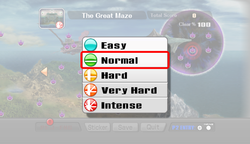Difficulty
Welcome to SmashWiki! Login or create an account and join the community, and don't forget to read this first! Notices Please participate in the discussion about the future of tier lists on this wiki. Editing Difficulty From SmashWiki, the Super Smash Bros. wiki Jump to navigationJump to search Warning.png You aren't logged-in. While it's not a requirement to create an account, doing so makes it a lot easier to keep track of your edits and a lot harder to confuse you with someone else. If you edit without being logged-in, your IP address will be recorded in the page's edit history. SmashBrosSymbol.svg Log in SmashBrosSymbol.svg Create account
24.177.0.172 12:00, December 18, 2020 (EST) 24.177.0.172 12:00, December 18, 2020 (EST) 24.177.0.172 12:00, December 18, 2020 (EST) 24.177.0.172 12:00, December 18, 2020 (EST) 24.177.0.172 12:00, December 18, 2020 (EST) 24.177.0.172 12:00, December 18, 2020 (EST) 24.177.0.172 12:00, December 18, 2020 (EST) 24.177.0.172 12:00, December 18, 2020 (EST) 24.177.0.172 12:00, December 18, 2020 (EST) 24.177.0.172 12:00, December 18, 2020 (EST) 24.177.0.172 12:00, December 18, 2020 (EST)
{ArticleIcons|ssb=positive|ssbm=positive|ssbb=positive|ssb4=positive|ssbu=positive}}
Difficulty is an option in some single player and co-op modes that allows a player to adjust the game after one's skill. Depending on what mode is being played, different difficulty levels will affect the game in different ways. For example, a higher difficulty level in the Subspace Emissary will make the enemies harder by giving them more HP and making their attacks stronger, while a higher difficulty level in Target Smash changes the stage's design into a more difficult one. Sometimes, unlockables such as trophies or stickers depend on the difficulty on which a game mode is cleared. In the Subspace Emissary, Stock Balls vary in number, from appearing in most levels in Easy to never appearing in Intense.
The setting appears for all games' Classic Modes (including Smash 64's 1P Game), Adventure Mode, Subspace Emissary, All-Star Mode and World of Light. Additionally, in Brawl, the setting is available for Boss Battles, and has been added to Event matches and Target Smash!!. However, the event matches in Super Smash Bros. Brawl and Super Smash Bros. 4 only have three difficulties (Easy, Normal, and Hard). Smash 4 also featured an entirely retooled difficulty scale for its Classic and All-Star Modes, as with Smash Ultimate on its Classic Mode.
Difficulty levels in Smash 64 and Melee
- Very Easy (blue difficulty)
- Easy (green difficulty)
- Normal (yellow difficulty)
- Hard (orange difficulty)
- Very Hard (red difficulty)
Difficulty levels in Brawl
 Easy (やさしい, Easy)
Easy (やさしい, Easy) Normal (ふつう, Normal)
Normal (ふつう, Normal) Hard (むずかしい, Hard)
Hard (むずかしい, Hard) Very Hard (とてもむずかしい, Very Hard)
Very Hard (とてもむずかしい, Very Hard) Intense (ゲキむず, Extreme)
Intense (ゲキむず, Extreme)
In Event Matches, only three difficulty levels are available: ![]() Easy,
Easy, ![]() Normal, and
Normal, and ![]() Hard.
Hard.
Difficulty levels in SSB4 and Ultimate
Difficulty levels were significantly overhauled in Smash 4. The game's retooled Classic Mode features the Fiend's Scale to determine the game's difficulty. In this system, the player is able to select an intensity from 0.0 to 9.0, with higher intensities leading to harder fights, but more rewards; the default intensity is 2.0 (which is free to start), and selecting other intensities requires some gold, with each .1 increment costing the player a set number of gold depending on the intensity. The system is identical to the Fiend's Cauldron intensity system from Masahiro Sakurai's previous game, Kid Icarus: Uprising, and it even uses the same titles.
Selecting an intensity lower than 2.0 also costs gold, with the amount increasing per decrement.
The difficulty chosen - in addition to making the CPU opponents tougher and the prizes greater - determines what is faced at the end of the game, with higher intensities adding new foes to the mix. In both versions, the encounter is as follows:
| Inclusion | Intensity range |
|---|---|
| Master Hand | All Intensities |
| Crazy Hand | 3.0 and Up |
| Master Edges & Master Shadow | 5.1 and Up |
| Master Beast | 6.0 and Up |
| Master Giant | |
| Master Fortress |
Every time the player loses, he or she is given the option to continue. If the player elects to continue, the intensity lowers by 0.5. Regardless of whether or not the player continues, some rewards attained in the Classic Mode will be lost, as will some gold on the Fiend's Scale.
The game's All-Star Mode and Event Matches, however, use the traditional difficulties, though only three are available: Easy, Normal, and Hard. Unlike in Brawl, however, the colors for Normal and Hard are yellow and red, respectively.
In Super Smash Bros. Ultimate, the intensity can no longer be initially increased past 5.0 in Classic Mode; however, the intensity can increase depending on the player's performance in each round. The more the intensity racks up, the more of the mural is shown. The intensity scale's effect on bosses will depend on certain characters. For example, Fox can only fight Crazy Hand if he's able to get the intensity high enough, but for characters like Mario or Simon, who have a different boss other than Master and Crazy Hand, the intensity will not add any additional bosses. Traditional difficulty settings can be found in the game's Adventure Mode: World of Light.












